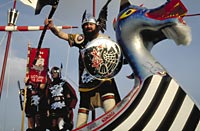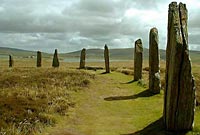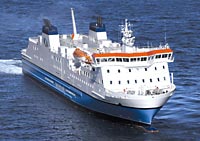Traveling to Scotland's Islands
Stones, Horses and
Prehistory
|
|
Click this map image to open up a larger map in a new window |
Scotland is a land of
outdoor beauty, of unspoiled nature, and of open spaces.
The purest Scottish experiences can be enjoyed in its
islands - places where time seems to - if not stand still,
then certainly move more slowly.
Part
1 of a
2 part series - click for Parts
One
Two |
There are three major island
groupings around Scotland - to the north, the Shetland and the
Orkney Islands, and to the west are the Hebrides, also known as
the Western Isles.
In this first part of the two
part series, we look at the northern islands.
Shetland Islands
The Shetland Islands have always been a source of fascination for visitors,
although few actually visit these far flung outer reaches of
Scotland.
They are the furtherest away of the
island groups are the Shetlands, enticing and mysterious as the
northernmost outpost of the United Kingdom. Sitting, wave-lashed
where the Atlantic Ocean meets the North Sea, they are closer to
Bergen in Norway than Aberdeen on the Scottish mainland.
Shetland is on the same latitude as the southern tip of
Greenland, Siberia and Alaska. To the north there is nothing but
hundreds of miles of ocean, until you reach Spitsbergen and the
Arctic wastes beyond.
Northlink operate new
ferries for the overnight sailing from the granite city of
Aberdeen to Lerwick, the Shetland capital, and Britain's
northernmost town. The vessels such as MV Hrossey
are reminiscent of small cruise ships, with bars,
restaurant, shop, cinema and comfortable two and four berth cabins equipped
with TV and en-suite bathroom.
Founded on the fishing
industry and with strong Viking connections, gray buildings
dating from the 17th century line the narrow, flagstone streets
of the quaint town of Lerwick.
The Shetland islanders are proudly independent. Though they send
members to the parliaments in both London and Edinburgh, you will see a lot more of
their unofficial Shetland flags, with a white cross on a blue
background, than you will of Scottish or Union flags.
 The
Shetland flag has a Scandinavian-style feel to it, indeed, these islands with their scattered,
squat homesteads, have quite a Scandinavian feel to them:
unsurprising as they were once Viking strongholds and belonged
to Norway until 1469. This heritage is celebrated in dramatic
fashion each January with the Up Helly Aa festival, when Viking
longships are set ablaze to the accompaniment of men in
warrior-dress and a thousand flaming torches. The
Shetland flag has a Scandinavian-style feel to it, indeed, these islands with their scattered,
squat homesteads, have quite a Scandinavian feel to them:
unsurprising as they were once Viking strongholds and belonged
to Norway until 1469. This heritage is celebrated in dramatic
fashion each January with the Up Helly Aa festival, when Viking
longships are set ablaze to the accompaniment of men in
warrior-dress and a thousand flaming torches.
The wild, peaty and rocky landscapes are remarkable in that they
are almost completely treeless: the salty winds from the
Atlantic take care of that. Also dotting the landscape are the
sturdy little Shetland ponies, bred in vast numbers from the
1850s for export to the collieries of Northern England, where
they earned their keep hauling coal deep underground.
The sea, or fingers of it, reach into every corner of the
the largest of the Shetland Islands (known as the Mainland) - for it is long and narrow - getting more and more
rugged as you travel south to Sumburgh Head. This is one of the
many places where you can enjoy the islands’ rich birdlife: the
sheer cliffs are alive with thousands of nesting puffins in May
and June, while seals and even whales play in the waves beyond. Mainland is the largest of 100 islands that make up the
Shetlands - though only 16 are inhabited.
This far north, the summer light lasts well into the night: 19
hours of daylight is usual at midsummer. The “Simmer Dim” as it
is called can be quite disorientating at first, but golfers are
overjoyed to be able to enjoy their sport at midnight!
The highlight for many
visitors, though, is a walk back in time at the Jarlshof Neolithic village, remarkably intact even after some
5,000 years, in its evocative setting near the water’s edge,
close to Sumburgh on the southern tip of Mainland Island.
Various ‘layers’ of history have been unearthed here, from a
second century BC settlement, through Viking and medieval farms.
Archaeologists also rave about the islands’ ancient brochs, a
sophisticated network of stone watchtowers dating from 100BC, of
which more than 120 remain.
More information about the
Shetland Islands can be found at
Visit
Shetland.
Orkney Islands
The Northlink ferries also call at the Orkney
Islands, not as far north as the Shetlands. This is a
group of 70 islands, of which only 17 are inhabited. The
closest of them is just 6.5 miles from John O'Groats on the
Scottish mainland (and ferries travel across from there).
 Rich in ancient sites, the Orkneys have extraordinary
remains of prehistoric villages, stone circles and tombs. King
of these is the Skara Brae stone village, a Neolithic village more ancient than
the Pyramids, entombed for centuries until a fierce storm in
1850 revealed its secrets. There is also an impressive
standing stone circle, the Ring of Brodgar. Rich in ancient sites, the Orkneys have extraordinary
remains of prehistoric villages, stone circles and tombs. King
of these is the Skara Brae stone village, a Neolithic village more ancient than
the Pyramids, entombed for centuries until a fierce storm in
1850 revealed its secrets. There is also an impressive
standing stone circle, the Ring of Brodgar.
Both these attractions are conveniently within a mile of each
other, and not far from the town of Stromness, where ferries
travel south to Scrabster (near Thurso at the top of Scotland).
The ferry that travels to/from Aberdeen and Lerwick in the
Shetlands calls at Kirkwall, which is also the home of the noted
Highland Park distillery, famous not only for its fine whisky
but also for being the world's northern most whisky distillery.
There are spectacular cliffs, wide
skies and huge horizons. The Orcadians are great craftspeople,
with a strong tradition of jewelry making as well as fine
knitwear, weaving and pottery.
Scapa Flow - Britain's great
naval base for the first half of the 20th century - also lies in
the Orkney Islands. The German Fleet scuttled itself there
at the end of World War One and there is now great diving to be
had into the clear waters and down to the wreck remains.
More information about the
Orkney Islands can be found on their
Tourist
Information website.
Getting to and around
Scotland's Northern Islands
 Ferry
schedules are seasonal, with the most frequent services being
operated in the summer, and some ferries not operating at all in
the winter. Ferry
schedules are seasonal, with the most frequent services being
operated in the summer, and some ferries not operating at all in
the winter.
For the northern islands of Orkney and Shetland,
Northlink
Ferries offer a two-night mini-cruise
starting at £299 per person including day tours of both islands,
ferry travel and two nights en-suite cabin accommodation.
The
Shetland Islands Council operates ferry service between nine
of the Shetland Islands.
Orkney
Ferries operate service between the main island and 13 of
the smaller islands in the Orkney Island group.
Smaller Ferry Services to and
in the Orkney and Shetland Islands
There is a small passenger
only ferry that travels between
John O'Groat's and Burwick in the Orkney Islands (a 40
minute journey).
There is another ferry
service for passengers and cars between
Caithness
(close to John O'Groats) and St Margarets Hope, Orkney.
Read more in Part 2
In
Part 2 we look at the
islands off Scotland's west coast - the inner and outer Hebrides
or the Western Isles.
Related Articles, etc
|
If so, please donate to keep the website free and fund the addition of more articles like this. Any help is most appreciated - simply click below to securely send a contribution through a credit card and Paypal.
|
Originally published
3 Aug 2004, last update
30 May 2021
You may freely reproduce or distribute this article for noncommercial purposes as long as you give credit to me as original writer.
|

